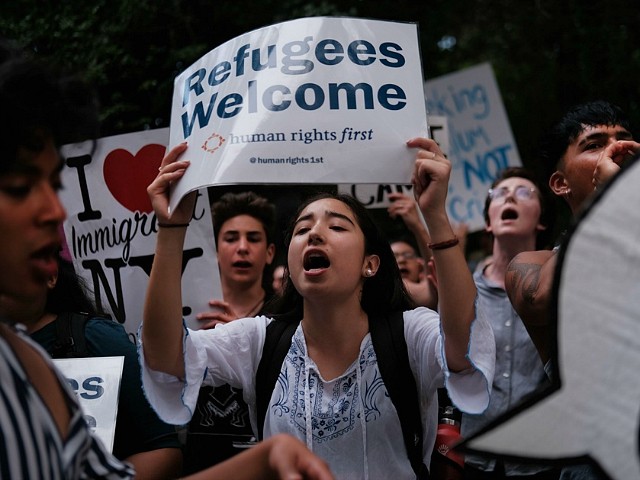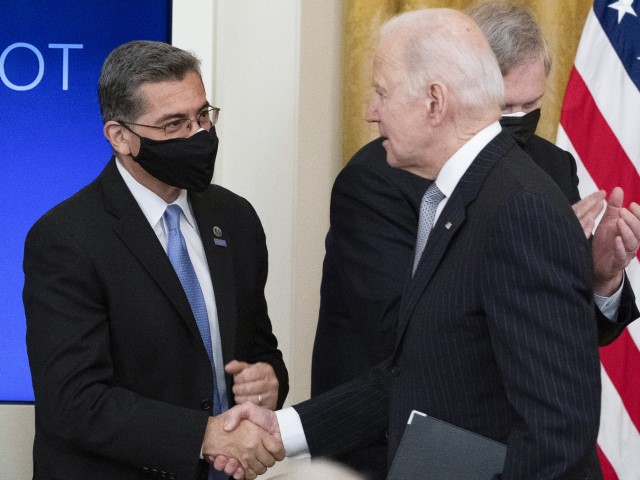The federal government won an 8.7 percent profit of $37.5 billion from the resident population of 2.9 million refugees and asylum seekers in the 15 years before 2020, says a celebratory report by the Department of Health and Human Services (HHS).
The report also notes that the imported refugees also inflicted a 7.3 percent loss of $21.4 billion on the taxpayers who fund state and local governments.
The report calculated the costs by comparing the $739 billion in taxes paid by migrants and their families to their $723.4 billion in government aid.
The claimed razor-thin profit of 2.1 percent was enabled by the report’s exclusion of many other costs paid by taxpayers.
The excluded costs include the migration damage to Americans’ wages, housing costs, civic stability, and economic productivity, according to the report titled “The Fiscal Impact of Refugees and Asylees at the Federal, State, and Local Levels from 2005 to 2019.”
The report also excluded some welfare programs, ancillary costs, and future huge costs of the migration — such as Medicare and Social Security.

Hundreds of people gather in front of U.S. Sen. Chuck Schumer’s Brooklyn apartment to protest the migrant detention facilities on July 02, 2019, in New York City. (Spencer Platt/Getty Images)
The report also hid useful information about the most expensive and least expensive categories of migrants, and it also hid regional gains and losses caused by the extra taxes and spending.
“They want the takeaway to be that refugees are good, period,” noted Jason Richwine, a statistician who works for the Center for Immigration Studies, adding:
They’re not trying to educate people on specifics, which really they should if they’re were trying to come up with a non-biased report. The truth is that higher-skilled immigrants, higher-educated immigrants will be net fiscal contributors and the less-educated, less-skilled immigrants will be net fiscal drains. This is not just common sense but also something we see the data all the time.
Federal officials are touting the skewed report to justify the importation of yet more refugees and asylum applicants.
“While this study focused exclusively on the impact on government budgets, this finding suggests that refugees and asylees do successfully integrate into the U.S. economy,” the report said while lamenting that former President Donald Trump’s migration cuts “continue to cost the economy billions of dollars per year.”
“I hope this report becomes a key reference for decision-makers in all levels of government when it comes to refugee resettlement,” HHS Secretary Xavier Becerra said in a February 15 agency statement.
The officials who prepared the self-serving report enthusiastically touted the tax gains to their fellow taxpayer-funded agency employees. One of the agency managers, Miranda Lynch-Smith, a deputy assistant secretary for Human Services policy, posted her support on LinkedIn:
We had a really great conversation with refugee agency leaders, Secretary Becerra, and ACF [Administration for Children and Families] leaders today about our report. Its clear that even though we welcome refugees and asylees for humanitarian reasons, they bring cultural richness, enhance community vibrancy, and – as we showed in our report – add a net positive economic contribution to the U.S.! There are so many reasons to do what is right and welcome and assist refugees and asylees.
Pro-migration activists are using the report to cheerlead for more migration. “As this HHS study makes clear, refugees and asylees may require an upfront investment by government at all levels, but those investments quickly pay off,” claimed the American Immigration Council.

Health and Human Services Secretary Xavier Becerra shakes hands with President Joe Biden after a “Cancer Moonshot” event in the East Room of the White House, Wednesday, Feb. 2, 2022, in Washington. (Alex Brandon/AP)
President Joe Biden’s deputies directly imported another 85,000 additional refugees in 2022 and 2023, including many lower-skilled refugees from African countries, such as the Republic of the Congo, alongside a flood of more than six million southern migrants.
Exclusions
The greatest costs excluded from the report, said Richwine, are likely the cost of “congestible public goods,” including police and emergency services, roads and parks. Those costs rise as the local population rises.
The exclusion “is difficult to defend [because] refugees surely increase the costs of these services,” he said, adding:
The authors try to argue that the [extra] cost is small because refugees are such a small portion of the national population, but they’re not spread evenly across the country — congestion costs in high-refugee communities add up.
The blue-ribbon 2016 report on immigration by the National Academies of Sciences, Engineering, and Medicine said on page 266 that excluding “congestible” costs effectively halved the up-front cost of migration:
A similar calculation shows that treating congestible goods (roads, police, etc.) as public goods with zero marginal costs would add $80,000 to the baseline NPV [Net Present Value], for a total of +$160,000 (National Research Council, 1997, p. 346).
The HHS report also excluded migrants’ share of public goods, saying, “Excluded are public goods related to military defense, support of foreign governments, and national security, as individuals cannot effectively be excluded from such services.”
The report also excluded predictable long-term liabilities, such as Social Security and Medicare, especially for migrants who work only a few years before retiring. “As adults reach retirement age, they are typically more costly to government, based on the use of programs such as Social Security and Medicare and lower contributions through income and payroll taxes,” the report noted.
“You do need a long-term analysis if you really want to get this right,” said Richwine. “They’re upfront about the fact that this is a static thing … [even though] programs are especially generous to legal immigrants because they give out a [relatively] higher payout for your [taxes] when you’re a shorter career worker or are a lower earner.”
The report ignored the long-term impact of refugees and migrants’ children on national productivity and wealth, saying: “To the authors’ knowledge, longitudinal data on refugees and asylees in particular are not collected, which impacts our ability to study second-generation outcomes for refugees and asylees and to track broader economic impacts, secondary effects, or long-term costs.”
The report discounted migration’s large impact on Americans’ wages and housing, saying:
This report does not consider second-order economic effects as a result of refugees and asylees entering the labor market. For example, their participation in the U.S. labor force may affect occupational structure, employment level, or wages among non-refugee populations, which in turn could affect the tax revenue collected by the government … There may be important costs in local areas where refugees and asylees make up a more substantial share of the population.
That exclusion “is defensible because second-order effects are really hard to measure,” Richwine said.
The report also hid details about which national groups of migrants are burdensome or profitable, even as it accepted an optimistic estimate of their skill levels compared to other surveys, Richwine said.
“These authors say that 29 percent of refugees who arrived within the past five years have bachelor’s degrees [See Table 5], but the ASR says that only 11 percent have a bachelor’s upon arrival,” [See Table 12], he said.
“All you need to do is look at the education levels in surveys like the annual survey of refugees which shows an extremely large percentage actually have no education … That’s not the kind of group that could possibly be a net fiscal benefit,” no matter how diligently they work, he said.
Those group distinctions were spotlighted in a February 2024 report by Boston Indicators titled “Global Greater Boston,” which posted a chart showing how migrants from different nations tend to work at different skill levels:
Some migrants — mostly Indians and Chinese — are imported for skilled jobs via the H-1B and other white-collar visa programs, the Boston report said, adding:
Immigrants are present in virtually every type of workplace in Greater Boston, they are much more likely than U.S.-born workers to be in low-wage jobs, where the median wage is below $49,000. Many of these are service occupations, where immigrants account for the vast majority of all workers in the field. For example, immigrants account for 78 percent of maids and housekeepers, 51 percent of cooks, and 51 percent of janitors and building cleaners, disproportionately more than their 25 percent share of the labor force.
The HHS report dodged the group issue, saying:
The current study is also unable to estimate variance in the fiscal impact of refugee subgroups. The fiscal impact of a specific group of refugees is likely to differ by key characteristics, such as time in the United States, pre-resettlement experiences with violence or trauma, employment in the home country, English proficiency, education, and age at entry. A study of greater depth and precision could account for the need for medical assistance and counseling, or human capital possessed by refugees at the time of arrival, and the related effects on fiscal costs and benefits.
The inflow of lesser-skilled migrants does drag down the nation’s per-capita wages and skill levels but is still profitable for government and business by expanding the nation’s population and economy
Government agencies gain when they import migrants who rely on government aid to prosper in a high-tech society, Richwine said. “Lower-skilled individuals — whether they’re working or not — definitely provide more clients for the welfare state, there’s no doubt about that.”
Investors and CEOs gain from any inflow of people who want to work, consume, and rent housing. “The [2023] immigration surge contributed significantly to easing labour shortages, slowing inflation, and lifting consumer demand,” said Ruchi Sharma, an Indian-born investor who runs the international side of the huge $65 billion Rockefeller Foundation. “Net migration to the US accounted for roughly one-quarter of the increase in consumer spending — a healthy 2.7 percent last year,” he wrote in a January 14, 2024, article for the Financial Times.
Still, the report’s recognition of the direct taxpayer costs is a useful corrective to the many media articles and business-backed reports and studies that only out the taxes paid by migrants while ignoring the costs.
Extraction Migration
Since at least 1990, the federal government has relied on Extraction Migration to grow the economy after allowing investors to move the high-wage manufacturing sector to lower-wage countries.
The migration policy extracts vast amounts of human resources from needy countries. The additional workers, consumers, and renters push up stock values by shrinking Americans’ wages, subsidizing low-productivity companies, boosting rents, and spiking real estate prices.
The economic policy has pushed many native-born Americans out of careers in a wide variety of business sectors, reduced native-born Americans’ productivity and political clout, reduced high-tech innovation, crippled civic solidarity, and allowed government officials and progressives to ignore the rising death rate of discarded Americans.
The colonialism-like policy has killed hundreds of Americans and thousands of migrants, including many on the taxpayer-funded jungle trail through the Darien Gap in Panama.


COMMENTS
Please let us know if you're having issues with commenting.